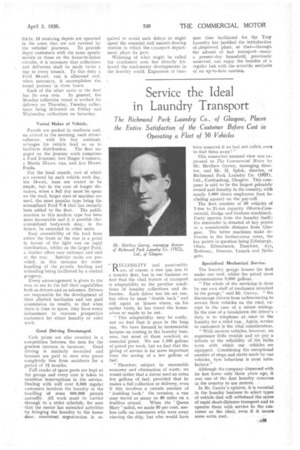Service the Ideal in Laundry Transport
Page 61

If you've noticed an error in this article please click here to report it so we can fix it.
Richmond Park Laundry Co., of Glasgow, Places Entire Satisfaction of the Customer Before Cost in Operating a Fleet of 50 Vehicles " D ELTABILITY" and punctuality
IN are, of course, a sine qua non in a laundry fleet, but in our business we find that the vital feature of transport is adaptability to the peculiar conditions of laundry collections and deliveries. Each driver has his set run, but often he must 'double back' and call again at houses where, on his earlier visits, he has found the housewives or maids to be out.
"This adaptability may be costly, but we find that it pays in the long run. We have listened to innumerable lectures on costing in the laundry-business, but most of them overlook an essential point. We use 1,300 gallons of petrol per week, but we find that the giving of service is far more important than the saving of a few gallons of fuel, "Therefore, subject to reasonable economy and elimination of waste, we would rather that a driver used an extra few gallons of fuel, provided that he makes a full collection or delivery, even if this involves a certain' amount of doubling back.' On occasion, a van may travel as many as 40 miles on a
fruitless errand. When the 'Queen Mary 'sailed, we made 50 per cent. useless -calls on customers who were away viewing the ship, but who would have
been annoyed if we bad not called, even to find them away! "
This somewhat unusual view was expressed to The Commercial Motor by -Mr. Matthew Garrey, managing director, and Mr. H. Spink, director, ot Richmond Park Laundry Co. (1927), Ltd., Cambuslang, Glaseow. This company is said to be the largest ;privately owned unit laundry in the country, 1:Vith nearly 1,000 direct employees (not, including agents) on the pay-roll..
The fleet consists of 50 vehicles, of 1-ton to 21-ton capacity (Morris-Commercial, Dodge and Graham machines). Forty operate from the, laundry itself ; the remainder is situated at key points at a considerable distance from Glasgow. The latter machines make deliveries in the farther-away areas, the key points in question being Edinburgh, Oban, Kilmarnock, Dumfries, Ayr, Rothesay, Dunoon, Lanark. and Bathgate.
Specialized Mechanical Service.
The laundry garage housesthe fleet under one roof, whilst thepetrel store accommodates 8,000 • gallons.. •
"The whole of the servicing. is done by our own staff of mechanics attached to the garage," said Mr. Garrey. "We discourage drivers' from endeavouring to service their vehicles on the road, except in the case of a miner, mishap. In the case of a breakdown the driver's duty is to 'telephone at. once: to the laundry foraxelief van. Again, service to customers is the vitaLconsideration.
" With modern Vehicles, however, we experience little trouble and we pay a tribute to the reliability of , the India tyres. with which our vehicles are equipped. Considering the exceptional number of stops and starts made by our vehicles, tyre behaviour is most satisfactory."
Although the company dispensed with its, last horse only three years ago, it was one of the first laundry concerns
in the country to use motors. • In Mr. Garrey's opinion, it is essential in the laundry business to .select types
• of vehicle that will withstand the stress of rapid short-distance-transport and to operate them with service to the customer 'as the ideal, even if it incurs some extra cost.-












































































































